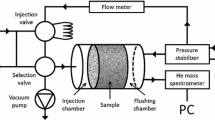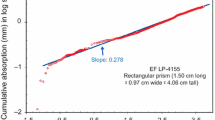Abstract
Uptake of noble gases into heterogeneous geologic core samples was measured using a piezometric methodology. In addition to measuring accessible porosity—as with gas pycnometry—by monitoring the rate of pressure decay, this method can also be used to estimate the gas effective diffusivity in the sample. In contrast to previous applications of this method, where milligram quantities of fractured grains are characterized, here approximately kilogram core samples were left intact when tested. In doing so, a more representative sample of the heterogeneous field geology is provided. Additionally, alteration of the pore structure and connectivity during sample preparation is avoided. To scale the piezometric method from milligrams to kilograms, the system was designed to operate at medium vacuum (1 to 100 Pa) to restrict transport in pores less than approximately 60 µm to large Knudsen numbers. To test the system performance, two samples of interest were selected: a rhyolitic welded tuff from Blue Canyon Dome at the Energetic Materials Research and Testing Center and a zeolitized non-welded rhyolitic tuff from the Nevada National Security Site. Three noble gases were utilized in this test series; Argon and xenon as they are of direct interest to nuclear monitoring efforts and helium as it is a weakly adsorbing reference standard. Additionally, mercury intrusion porosimetry measurements were made on subsamples of the core to compare the observed porosity by the two methods and to discuss gas transport rates in the context of the measured pore distribution.
Article Highlights
-
The piezometric method was extended to measure transport in intact geologic core samples between 800 and 1400 g.
-
Transport in the pores spaces was restricted to Knudsen flow using medium vacuum, enabling a closed-form solution.
-
Argon and xenon in a zeolitized tuff core exhibited significant adsorption and enhanced transport relative to helium.




Similar content being viewed by others
Availability of data and materials
The raw data are available upon reasonable request.
Code availability
Curve fitting was performed using MATLAB and the scripts written are available upon reasonable request.
References
Ackley, M.W., Rege, S.U., Saxena, H.: Application of natural zeolites in the purification and separation of gases. Microporous Mesoporous Mater. (2003). https://doi.org/10.1016/S1387-1811(03)00353-6
Anovitz, L.M., Cole, D.R.: Characterization and analysis of porosity and pore structures. Rev. Mineral. Geochem. (2015). https://doi.org/10.2138/rmg.2015.80.04
Ash, R., Barrer, R.M., Edge, A.V.: Diffusion coefficients of paraffins in a graphon membrane: the early time procedure. J. Chem. Soc. Faraday Trans. (1976). https://doi.org/10.1039/F19767202777
Auer, L.H., Rosenberg, N.D., Birdsell, K.H., Whitney, E.M.: The effects of barometric pumping on contaminant transport. J. Contam. Hydrol. (1996). https://doi.org/10.1016/S0169-7722(96)00010-1
Bear, J.: Dynamics of Fluids in Porous Media. American Elsevier, New York (1972)
Brandani, S.: Analysis of the piezometric method for the study of diffusion in microporous solids: isothermal case. Adsorption (1998). https://doi.org/10.1023/A:1008831202564
Brandani, S., Brandani, F., Mangano, E., Pullumbi, P.: Using a volumetric apparatus to identify and measure the mass transfer resistance in commercial adsorbents. Microporous Mesoporous Mater. (2020). https://doi.org/10.1016/j.micromeso.2019.01.015
Bülow, M., Micke, A.: Determination of transport coefficients in microporous solids. Adsorption (1995). https://doi.org/10.1007/BF00704144
Bülow, M., Mietk, W., Struve, P., Lorenz, P.: Intracrystalline diffusion of benzene in NaX zeolite studied by sorption kinetics. J. Chem. Soc. Faraday Trans. (1983). https://doi.org/10.1039/F19837902457
Carman, P.C.: Flow of Gases Through Porous Media. Academic Press, New York (1956)
Carrigan, C.R., Heinle, R.A., Hudson, G.B., Nitao, J.J., Zucca, J.J.: Trace gas emissions on geological faults as indicators of underground nuclear testing. Nature (1996). https://doi.org/10.1038/382528a0
Davidson, G.R.: Use of SF6 to label drilling air in unsaturated fractured rock studies: risk of over-purging. Appl. Geochem. (2002). https://doi.org/10.1016/S0883-2927(02)00044-6
Feldman, J., Paul, M., Xu, G., Rademacher, D.X., Wilson, J., Nenoff, T.M.: Effects of natural zeolites on field-scale geologic noble gas transport. J. Environ. Radioact. (2020). https://doi.org/10.1016/j.jenvrad.2020.106279
Geddis, A.M., Guzman, A.G., Bassett, R.L.: Rapid estimate of solid volume in large tuff cores using a gas pycnometer, NUREG/CR-6457 (1996)
Gilliland, E.R., Baddour, R.F., Perkinson, G.P., Sladek, K.J.: Diffusion on surfaces. I. Effect of concentration on the diffusivity of physically adsorbed gases. Ind. Eng. Chem. Fundamen. (1974). https://doi.org/10.1021/i160050a001
Hwang, S., Kammermeyer, K.: Surface diffusion in microporous media. Can. J. Chem. Eng. (1966). https://doi.org/10.1002/cjce.5450440206
Johnson, D.L., Koplik, J., Dashen, R.: Theory of dynamic permeability and tortuosity in fluid-saturated porous media. J Fluid Mech. (1987). https://doi.org/10.1017/S0022112087000727
Johnson, C., Aalseth, C.E., Alexander, T.R., et al.: Migration of noble gas tracers at the site of an underground nuclear explosion at the Nevada National Security Site. J. Environ. Radioact. (2019). https://doi.org/10.1016/j.jenvrad.2019.106047
Kast, W., Hohenthanner, C.R.: Mass transfer within the gas-phase of porous media. Int. J. Heat Mass Transfer (2000). https://doi.org/10.1016/S0017-9310(99)00158-1
Klinkenberg, L. J.: The permeability of porous media to liquids and gases. Drilling and Production Practice (1941)
Knowlton, G.D., White, T.R., McKague, H.L.: Thermal study of types of water associated with clinoptilolite. Clays Clay Miner. (1981). https://doi.org/10.1346/CCMN.1981.0290510
Krishnamurthy, S., Blom, R., Ferrari, M.C., Brandani, S.: Adsorption and diffusion of CO2 in CPO-27-Ni beads. Adsorption (2020). https://doi.org/10.1007/s10450-019-00162-x
Linneman, D., Sprinkle, P., Knox, H.A., et al.: Baseline characterization for change detection with joint inversion ERT and campaign seismic data. American Geophysical Union, Fall Meeting 2019 (2019)
March, H.W., Weaver, W.: The diffusion problem for a solid in contact with a stirred liquid. Phys. Rev. (1928). https://doi.org/10.1103/PhysRev.31.1072
McQuarrie, D.A., Simon, J.D.: Physical Chemistry: A Molecular Approach. University Science Books, Sausalito (1997)
Nilson, R.H., Peterson, E.W., Lie, K.H., Burkhard, N.R., Hearst, J.R.: Atmospheric pumping: a mechanism causing vertical transport of contaminated gases through fractured permeable media. J. Geophy. Res. Solid Earth (1991). https://doi.org/10.1029/91JB01836
O’Hanlon, J.F.: A User’s Guide to Vacuum Technology. John Wiley & Sons, Hoboken (2003)
Olsen, K.B., Kirkham, R.R., Woods, V.T., et al.: Noble gas migration experiment to support the detection of underground nuclear explosions. J. Radioanal. Nucl. Chem. (2016). https://doi.org/10.1007/s10967-015-4639-7
Paul, M.J., Biegalski, S.R., Haas, D.A., et al.: Xenon adsorption on geological media and implications for radionuclide signatures. J. Environ. Radioact. (2018). https://doi.org/10.1016/j.jenvrad.2018.01.029
Paul, M.J., Broome, S., Kuhlman, K.L., et al.: An experimental method to measure gaseous diffusivity in tight and partially saturated porous media via continuously monitored mass spectrometry. Transp. Porous Media (2020). https://doi.org/10.1007/s11242-020-01397-x
Shindo, Y., Hakuta, T., Yoshitome, H., Inoue, H.: Gas diffusion in microporous media in Knudsen’s regime. J. Chem. Eng. Japan (1983). https://doi.org/10.1252/jcej.16.120
Sun, Y., Carrigan, C.R.: Thermally driven advection for radioxenon transport from an underground nuclear explosion. Geophys. Res. Lett. (2016). https://doi.org/10.1002/2016GL068290
Tamari, S.: Optimum design of the constant-volume gas pycnometer for determining the volume of solid particles. Meas. Sci. Technol. (2004). https://doi.org/10.1088/0957-0233/15/3/007
Wilson, A.H.: V. A diffusion problem in which the amount of diffusing substance is finite. Philos. Mag. (1948). https://doi.org/10.1080/14786444808561166
Wu, K., Li, X., Wang, C., Yu, W., Chen, Z.: Model for surface diffusion of adsorbed gas in nanopores of shale gas reservoirs. Ind. Eng. Chem. Res. (2015). https://doi.org/10.1021/ie504030v
Acknowledgements
The authors would like to thank Scott Broome for his support of this work, as well as Kris Kuhlman for his valuable feedback. This research was funded by the National Nuclear Security Administration, Defense Nuclear Nonproliferation Research and Development (NNSA DNN R&D). The authors acknowledge important interdisciplinary collaboration with scientists and engineers from LANL, LLNL, MSTS, PNNL, and SNL. This paper describes technical results and analysis. Any subjective views or opinions that might be expressed in the paper do not necessarily represent the views of the U.S. Department of Energy or the United States Government. Sandia National Laboratories is a multi-mission laboratory managed and operated by National Technology & Engineering Solutions of Sandia, LLC, a wholly owned subsidiary of Honeywell International Inc., for the U.S. Department of Energy's National Nuclear Security Administration under contract DE-NA0003525, SAND2021-7800 J.
Funding
All work was funded by the United States National Nuclear Security Administration, Defense Nuclear Nonproliferation Research and Development (NNSA DNN R&D).
Author information
Authors and Affiliations
Corresponding author
Ethics declarations
Competing interests
The authors have no conflicts of interest to declare that are relevant to the content of this article.
Additional information
Publisher's Note
Springer Nature remains neutral with regard to jurisdictional claims in published maps and institutional affiliations.
Rights and permissions
About this article
Cite this article
Paul, M., Feldman, J. Measuring Gas Transport and Sorption in Large Intact Geologic Specimens via the Piezometric Method. Transp Porous Med 139, 1–20 (2021). https://doi.org/10.1007/s11242-021-01627-w
Received:
Accepted:
Published:
Issue Date:
DOI: https://doi.org/10.1007/s11242-021-01627-w




